classic muse
Tuesday, October 19, 2010
Monday, March 27, 2006
Violin duet
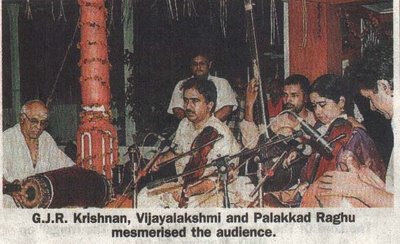
Innumerable concerts by GNB, along with Lalgudi Jayaraman and Palakkad Raghu, including the unforgettable one at TDM hall of Kochi in the late Fifties, have left an indelible impression on rasikas. So also the Lalgudi solo, teamed up with Raghu at Sree Poornathrayeesa Sangeetha Sabha in Tripunithura, diring the late Seventies. When G.J.R Krishnan and Vijayalakshmi, children of Lalgudi, perfromed with Raghu at Bhakthameera temple at Vyttila in Kochi in connection with the 34th installation day ceremony of the Sanctum Sanctorum there , it evoked nostalgia.
The way in which Raghu navigated the violin duet with his timely ‘pharans, ‘tekhas’ and ‘theermanam, embellished with the ‘ghumkhi’ of the left-bass, was bewitching. The duo had no hesitation in following Raghu right from the Asaveri varnam (jalajaksha in Aadi) which was created by Lalgudi. Raghu not given to theatrical gesture encouraged the youngsters with a benevolent smile whenever they made chaste improvisations.
Krishnan showed a refined dexterity while Vijayalakshmi stuck to the unorhodox style. Marupaadayaa in Mohanam in Aadi by Chinna Devudu was played with graceful glides, according it a heaviness that is not usually experienced in instrumental concerts even by leading maestros. This is owing to the simultaneous vocal training they received from their father. Dhanyasi unspooled smoothly with Meenalochani in chappu by Syama Sasthri.
The way in which Raghu navigated the violin duet with his timely ‘pharans, ‘tekhas’ and ‘theermanam, embellished with the ‘ghumkhi’ of the left-bass, was bewitching. The duo had no hesitation in following Raghu right from the Asaveri varnam (jalajaksha in Aadi) which was created by Lalgudi. Raghu not given to theatrical gesture encouraged the youngsters with a benevolent smile whenever they made chaste improvisations.
Krishnan showed a refined dexterity while Vijayalakshmi stuck to the unorhodox style. Marupaadayaa in Mohanam in Aadi by Chinna Devudu was played with graceful glides, according it a heaviness that is not usually experienced in instrumental concerts even by leading maestros. This is owing to the simultaneous vocal training they received from their father. Dhanyasi unspooled smoothly with Meenalochani in chappu by Syama Sasthri.
The style in which Vijayalakshmi played Kedara Gaula had more propinquity to that of her father’s and earned a lavish applause along with Venuganalola in roopakam by Tyagaraja. Rudrapriya followed by Amba Paradevathe in Ghandachappu by Tirunelveli Krishna Swamy Iyer paved the way for a well spread out Kambhoji followed by Sreeraghuvaraaprameya by Tyagaraja in Aadi.
Again it was Krishnan who unrolled Shanmukhapriya and the initial portion of the pallavi was sung by Vijayalakshmi. Nalinakanthi, Sahana, Varali, Ataana and Behaug were woven into it and it mesmerised the listeners. Tripunithura Radhakrishnan played the ghatom with his usual gusto.
Again it was Krishnan who unrolled Shanmukhapriya and the initial portion of the pallavi was sung by Vijayalakshmi. Nalinakanthi, Sahana, Varali, Ataana and Behaug were woven into it and it mesmerised the listeners. Tripunithura Radhakrishnan played the ghatom with his usual gusto.
By Courtesy – The Hindu-Kchi-Feb.25-04
Veena Gayathri at Thrippunithura

In the late sixties, a mere slip of a girl came on to the platform with the veena and started playing at the Sree Parthasarathy Swami Sabha in Triplicane at Chennai. At the very persuasive touch of her Meettu; raga, krithi and sargam were not isolationist entities but merged with the strains of Nadopasana. In the front row, besides the noted vidwans of that period, there was the eminent musicologist, Prof. P. Sambamoorthy, who wrote later that if the rebirth of Veena Dhanammal was possible it is evidently in this girl, E. Gayathri who deserved an epithet as Veena Gayathri..E. gayathri performed at the recently concluded festival at Ckakkamkulangara temple at Tripunithura. She started with ‘Navaraga Varnam’ by Pattanam Subrahmania Iyer, followed by ‘Sree Ganapathini’ in Saurashtram from Prahlada Bhakthi Vijayam, an opera by Tyagaraja. ‘Sumasayaka’ in Karantaka Kaappi, a Padavarnam by Swathi Thirunal preceded the portrayal of Panthuvarali (Siva Siva Siva), Sree Raga (Endaro) and Hindolam with ‘Saama Gaana Lolane’ by Papanasam Sivan, respectively. Each had a congruous set of manodharama swara, pasted to it. Then she played Yadukula Kambhoji, with ‘Divakarathanujam’, a Navagraha Krithi by Deekshithar, followed by a depiction of Arabhi (Paalimparaa by Pallavi Seshaier), as an appetiser to a tantalizing Kambhoji, in which the Thaanam was woven around thodi, poorvikalyani, kanada and madhyamavathi. The mridangam accompaniment by Trichur Narendran was an object lesson for budding percussionists. . Tripunithura Radhakrishnan with the ghatom did not lag behind. Manasi Prasad from Bangalore who is also an accomplished Bharata Natyam artiste, was highly rated by the audience for her sweet and weighty singing, with her main focus resting on the medium tempo. Her rendition of ‘Kaayaarohaneswaram’ by Deekshithar in Devagandharam or Abheri, set to Roopakam, got a thunderous ovation. Poorvikalyani had a captivating lay-out which the young Engineering graduate built up with enviable craft. ‘Gangadhara’ by Mysore Sadasiva Rao in Roopakam had niraval and kalpanaswara. Dayakar (Bangalore), with the violin, Bangalore B.S. Anand (mridangam), and Adichanallur Anil Kumar in charge of the ghatom, acquitted themselves well. Young Harihara Subrahmaia Iyer, from Senkottai has a geniality and an aptitude to reach out to the listeners, reminiscent of the late Madurai Somu. Iyer began with the varnam in Dhanyasi and drew a convincing map of the raga, Khamas. ‘Broche vaare’ had a few vibrant passages, followed by ‘Sabhapathikku’ in Abhogi by Gopalakrishna Bharati. His pallavi in Hamsanandi was meant for the initiated segment of the audience. Attukal Balasubramaniam was fluent on the violin. .Thrissur Jayaram (mridangam), Anil Kumar (ghatom) and T.Rajasekharan with the mukharsanghu performed with mutual understanding. K.N .Ranganatha Sarma always presents carnatic music as a polished product. His Mohanam, with Kaadambaree (thriputa) by Deekshithar and Mukhari, affixed to ‘Muripe’ (Tyagaraja) were charming, along with RTP in Panthuvarali. Violin by T.H.Subrahmaniam was appropriate. Palldam.R.Ravi, a descendant from the household of the legendary flutist Sanjivi Rao, mesmerised the listeners with his pleasing mridangam play. Radhakrishnan (ghatom) and T. Rajasekharan (mukharsanghu) did their job well. Girija Varma, hailing form a family of musical lineage in Tripunithura, impressed with her portrayal of Sankarabharanam and the presentation of Akshya Linga Vibho was steeped in Samparadaya. Then Saveri came with Murugaa-Murugaa by Periya Swamy Thuran. . V.K. Hariadas (violin), Tripunithura Neelakantan(mridangam) and Mangad Pramod (ghatom) provided an apt mode of accompaniment.
By Courtesy The Hindu (Kochi), 10.3.06
By Courtesy The Hindu (Kochi), 10.3.06
Keerthi Unni

Apart from T.H. Lalitha, Sindhu Nedumangadu, and the like there are hardly any professional women violinists in Kerala. Hence Keerthi Unni’s arrival has been welcomed by all. She has been gaining popularity as a Carnatic vocalist and member of Tripunithura Kathakali Kendram. She was trained by Kumari Varma in Kathakali music. She learned the violin from Dileep from Chottanikkara for a brief period and honed her skill with practice and by listening to concerts.
Owing to the absence of an opportunity to highlight the grace of the diction in a violin solo, Keerthi prefers vocal recitals. All the same her violin solo that was held in connection with the festival of Ernakulam temple, under the aegis of Kshethra Kshema Samithi, showed that she has a bright future if she dedicates herself to regular and formal training. There is a natural tonal strength in her playing which is free from a jarring screech, a common feature that mars recitals of beginners. She has a style that is slanted more towards the conventional and set up the tempo with the Ata thala varnam in Kambhoji to proceed with Annapoorne in Saama by Deekshithar and Endaro Mahanubhavulu before outlining Malayamarutham. Then came Manasaa etu lo by Tyagaraja. Her aesthetics came to the fore with Sankarabharanam and swaras grafted to Akshayalinga (Misrachappu) revealed how vocal training is helpful to a Carnatic instrumentalist when unfolding a major Deekshithar composition. Kaappi (Enna Thavam) by Papanasam Sivan and Alaipayuthe by Oothukadu Venkata Subbaier in Kanada followed. Tripunithura Subbaraman on the mridangam and Tripunithura Hari Swamy on the ghatom accompanied her.
Owing to the absence of an opportunity to highlight the grace of the diction in a violin solo, Keerthi prefers vocal recitals. All the same her violin solo that was held in connection with the festival of Ernakulam temple, under the aegis of Kshethra Kshema Samithi, showed that she has a bright future if she dedicates herself to regular and formal training. There is a natural tonal strength in her playing which is free from a jarring screech, a common feature that mars recitals of beginners. She has a style that is slanted more towards the conventional and set up the tempo with the Ata thala varnam in Kambhoji to proceed with Annapoorne in Saama by Deekshithar and Endaro Mahanubhavulu before outlining Malayamarutham. Then came Manasaa etu lo by Tyagaraja. Her aesthetics came to the fore with Sankarabharanam and swaras grafted to Akshayalinga (Misrachappu) revealed how vocal training is helpful to a Carnatic instrumentalist when unfolding a major Deekshithar composition. Kaappi (Enna Thavam) by Papanasam Sivan and Alaipayuthe by Oothukadu Venkata Subbaier in Kanada followed. Tripunithura Subbaraman on the mridangam and Tripunithura Hari Swamy on the ghatom accompanied her.
By Courtesy The Hindu-Kochi on 28.1.05
Friday, March 24, 2006
Panthula Rema in Tripunithura Chakkamkulangara temple.
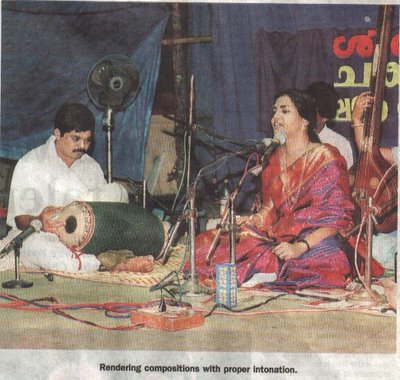
By creating raga pictures of beauty, rendering the compositions with the correct intonation and garnished with a cascade of ‘bhrigas’, Panthula Rema enthralled a massive audience at the Ckakkamkulangara temple at Tripunithura. Although the concert was fast paced throughout, the vocalist from Visakhapattanam complied thoroughly with the age-old traditions which make Carnatic vocal worth listening to.
The disciple of Evattoori Vijayeswara Rao, she, a post-graduate from Andhra University, is capable of playing the Viola as well. After the Ata- thala varnam in Bhairavi by which Pachimiriyam Aadiappayya (maanasaguru to Syama Sasthri with this single creation to his credit entered immortality), Rema set the tempo with Saranu Sidhi Vinayaka in Saurashtram by Purandardasa.
Thathwa meruga in Garudadhwani (roopakam) by Tyagaraja being a philosophical one, the vocalist emphasised each and every word of that small composition. Swaraprasthara done in the Sarvalaghu mode augmented the relationship between the Maathu (diction) and Dhathu or the notation. Yadukulakambhoji had enough repose in it. Divakara thanujam (Navagraha krithi) by Deekshithar was appreciable and the the devotional fervour in Bhogindrasayinam was efficiently brought to the fore. Then she mapped out Hameer Kalyani, packing it up with excitable passages of melodic grace. Tagged to the same was Vankatasaila vihara by Subbaraya Sasthri. Panthuvarali had nuances beyond the ordinary and Siva siva siva Yanaradha a didactic composition (Upadesha Kaaerthana) by Tyagabrahmam reminding one of the mystic significance in uttering the name of the Lord, thrice in succession. This became lustrous when the vocalist appended it with niraval and swara. M.S.N Moorthy, Rema’s husband gave a soothing accompaniment on the violin. V. V. Remana Moorthy on the mridangam brought in the speciality of the Andhra style flavoured with an emphasis on the ‘cholkettu. Adichanallur Anilkumar with the ghatom provided a stable rhythm.
By Courtesy The Hindu –Kochi-25.3.05
Saxophone recital at Ernakulam Siva Temple
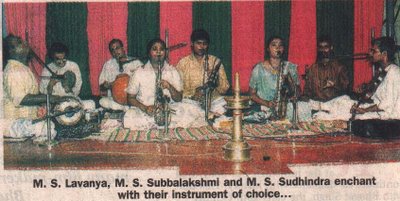
The purists among the Carnatic music lovers welcome the emergence of Saxophone as a concert instrument with a pinch of salt. They do not believe that the instrument can produce tonal texture suitable to the portrayal of rakthi ragas. If any one of these hardliners were to listen to a Saxophone concert by M.S. Lavanya, M.S. Subbalakshmi and M.S. Sudhindra from Mangalore he would have had to retract from his rigid views. The trio, grandchildren of the Asthana mridanga vidwan M.R. Rajappa of the earstwhile royal court of Mysore held the festival crowd at the Ernakulam Siva temple spellbound with their proficiency on the Western instrument.
Both Lavanya and Subbalakshmi are graduates (Sudhindra just has completed his Higher Secondary) and had vocal training from Nagaveni, Flute Gopalakrisna Iyer of Tripunithura (settled in Mangalore), M. Srinath Maratte (AIR) before learning the technique of the instrument from Kadri Gopalnath. Lavanya leading the concert with her younger sister joining it from time to time seemed to be a well-conceived idea, lest the Sahithya part be drowned by the high-pitch playing from the duo.
Sudhindra’s task was to provide the drone or ‘ottu’. Varnam in Valaji composed by Lalgudi was followed by a graceful Hamsadhwani and the ‘sargam’ attached to Mahaganapathim by Indira Nateshan was consummated with a Mohara. Pariyaachakamaa in Vanaspathi (formerly as known as Bhanumathi) set to roopakam in which Tyagaraja appeals to the Lord of refuge, was played in slow tempo. Raja raja raadhithe by Harikeshanallur Muthayya Bhagavthar , designed in the raga Neeroshta, has to be intonated with special lip movements when presented vocally and the sisters played it conforming to its pattern on the difficult instrument Panthuvarali was given elegance by Lavanya, with the composition Siva siva Siva. Ranjani mridu with its delectable score by Thanjavur Sankara Iyer made way for a Swarajathi, created by Syama Sasthri. Kamakshi Anudinamu was cleanly presented, with its peculiar rhythm set –up in ‘Viloma chaappu’. Despite the brief spell of summer showers playing spoilsport, the sisters surged ahead with the depiction of Mohanam and the swaras fastened to Nanu palimpa had a scintillating finish. Baaro Krishnayya by Purandaradasa, Brahma mukate in Bowli by Annamacahrya and a folk tune in Punnagavarali, helped them to finish the recital. Edappally Ajith bowed on with relish. Mysore Rajappa Sainath (father of the trio) handled mridangam and dholak with expertise. Alappuzha Gopinatha Prabhu (ghatom) and Kottayam Murali twanging the mukharsankhu were efficient.
Both Lavanya and Subbalakshmi are graduates (Sudhindra just has completed his Higher Secondary) and had vocal training from Nagaveni, Flute Gopalakrisna Iyer of Tripunithura (settled in Mangalore), M. Srinath Maratte (AIR) before learning the technique of the instrument from Kadri Gopalnath. Lavanya leading the concert with her younger sister joining it from time to time seemed to be a well-conceived idea, lest the Sahithya part be drowned by the high-pitch playing from the duo.
Sudhindra’s task was to provide the drone or ‘ottu’. Varnam in Valaji composed by Lalgudi was followed by a graceful Hamsadhwani and the ‘sargam’ attached to Mahaganapathim by Indira Nateshan was consummated with a Mohara. Pariyaachakamaa in Vanaspathi (formerly as known as Bhanumathi) set to roopakam in which Tyagaraja appeals to the Lord of refuge, was played in slow tempo. Raja raja raadhithe by Harikeshanallur Muthayya Bhagavthar , designed in the raga Neeroshta, has to be intonated with special lip movements when presented vocally and the sisters played it conforming to its pattern on the difficult instrument Panthuvarali was given elegance by Lavanya, with the composition Siva siva Siva. Ranjani mridu with its delectable score by Thanjavur Sankara Iyer made way for a Swarajathi, created by Syama Sasthri. Kamakshi Anudinamu was cleanly presented, with its peculiar rhythm set –up in ‘Viloma chaappu’. Despite the brief spell of summer showers playing spoilsport, the sisters surged ahead with the depiction of Mohanam and the swaras fastened to Nanu palimpa had a scintillating finish. Baaro Krishnayya by Purandaradasa, Brahma mukate in Bowli by Annamacahrya and a folk tune in Punnagavarali, helped them to finish the recital. Edappally Ajith bowed on with relish. Mysore Rajappa Sainath (father of the trio) handled mridangam and dholak with expertise. Alappuzha Gopinatha Prabhu (ghatom) and Kottayam Murali twanging the mukharsankhu were efficient.
(By Courtesy The Hindu- Kochi) Feb 1- 2002.
Thursday, March 23, 2006
Vasundhara Rajagopal at the Sree Poornathrayeesa temple.
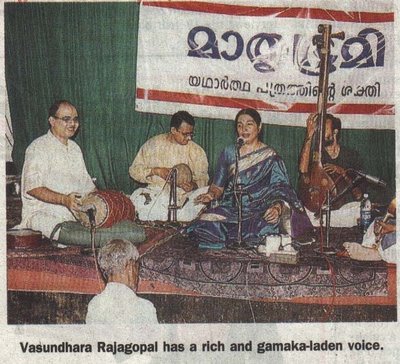
A disciple of T.R. Subrahmaniam, Vasundhara Rajagopal gave an admirable performance on the 3rd day of the Poornathrayesha temple festival. A rich and gamaka-laden voice made the ragas endearing and the intonation of the compositions had a natural chime in them. After a comprehensive etching of Mayamalaava gaula and Deva deva decorated with kalpanasweras, she came up with a delicious Keeravani.. The pallavi wound around Kanada, Revathi. and Dharmavathy. H.N. Bhaskar was noticeable with the bow with a trace of MSG, his guru, in him. Nellai Balaji and Rajagopalan gave an exemplary rhythm with the mridangam. and ghanjira respetively. On the Aarattu day there was high excitement, owing to the violin solo by L.Subrahmaniam who was performing for the first time at the main temple in his home town. Promoted by Palakkad Mani Iyer he learnt early in his life the way to mesmerise the audience with a refined technique, remaining on the basics he learned from his father, Lakshminarayanan. The miniscule variations brought in Vathapi incorporating the occidental techniques such asVibrato (shaking of the same note), Glissando (wide sweeps) and Legato(upward and downward movements of the fingers) and a downpour of swaras in Niravadhi in Ravichandrika by Tyagaraja attracted a prolonged applause. Mridangam patriarch T.K. Moorhty’ s prowess on the mridangam would have brought immense pleasure to his guru, Thanjavur Vaidyanataha Iyer, had he been present on such a serene occasion. The protracted “korvais” he presented during the ‘Thani’ were well deciphered and reproduced by Tripunithura Radhakrishnan with the ghatom.
By Courtesy The Hindu Kochi.-Dec24.2004.
Dr. K. Omanakutty for Avishkar in Kochi
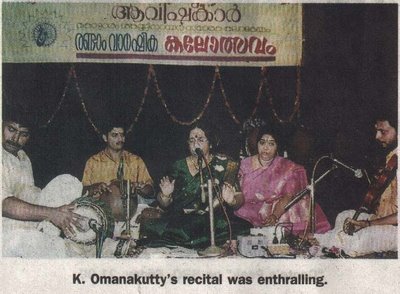 There has been always a freshness about a vocal by K. Omanakutty because of her ability to select the best compositions by the best Vaaggeyakaras of modern times and those of the past and mesh them appropriately. She chooses ragas which are easy on the rasikas and renders krithis in the medium tempo in order to keep the programme on an even keel. Her vocal at Gangothri Mandapam in Kochi in connection withthe second anniversary of Avishkar (Harmonium Wizard Kottaram Sankunni Nair Smaraka Kendram) had a smooth sailing. Despite a belated start the vocalist enticed the listeners with a catchy Bhajaamahe (Thulaseevanam) in Hamsadhwani, redolent with flourishes with which she usually begins a concert. Kanada was fluent and the stately patterns of swaras, attached to Maamava sadaa must have been beneficial to several upcoming vocalists and instrumentalists, undergoing training in Avishkar. Murukaa Murukaa in Saveri (chaappu) by Periya Swamy Thuran and Himagirithanaye in Sudhadhanyasi by Muthayya Bhagavathar eventually led to the lucid description of Poorvikalyani. Santhana Gopalamoorthe by Narayanankutty Menon composed on Lord Poornathrayeesa, moved the listeners. Then came a fastish Bhogindrasayinam whish is said to have been composed by Maharaja Swathi Thirunal by drawing inspiration from Sreerangasayinam by Margadarshi Seshayyangar of the pre- Trinity era. Attulal Balasubramanian showed good anticipation on the violin. Cherthala Jyadevan (mridangam) and Changanasseri Krishnakumar with the ghatom supplied an agreeable percussion.
There has been always a freshness about a vocal by K. Omanakutty because of her ability to select the best compositions by the best Vaaggeyakaras of modern times and those of the past and mesh them appropriately. She chooses ragas which are easy on the rasikas and renders krithis in the medium tempo in order to keep the programme on an even keel. Her vocal at Gangothri Mandapam in Kochi in connection withthe second anniversary of Avishkar (Harmonium Wizard Kottaram Sankunni Nair Smaraka Kendram) had a smooth sailing. Despite a belated start the vocalist enticed the listeners with a catchy Bhajaamahe (Thulaseevanam) in Hamsadhwani, redolent with flourishes with which she usually begins a concert. Kanada was fluent and the stately patterns of swaras, attached to Maamava sadaa must have been beneficial to several upcoming vocalists and instrumentalists, undergoing training in Avishkar. Murukaa Murukaa in Saveri (chaappu) by Periya Swamy Thuran and Himagirithanaye in Sudhadhanyasi by Muthayya Bhagavathar eventually led to the lucid description of Poorvikalyani. Santhana Gopalamoorthe by Narayanankutty Menon composed on Lord Poornathrayeesa, moved the listeners. Then came a fastish Bhogindrasayinam whish is said to have been composed by Maharaja Swathi Thirunal by drawing inspiration from Sreerangasayinam by Margadarshi Seshayyangar of the pre- Trinity era. Attulal Balasubramanian showed good anticipation on the violin. Cherthala Jyadevan (mridangam) and Changanasseri Krishnakumar with the ghatom supplied an agreeable percussion. By Courtesy The Hindu – Kochi-4-3- 05.
Sowmya at Rasikapriya.

Carnatic vocalist S. Sowmya is no stranger to Kochiites, at least to the older generation, as she had spent her childhood in Eloor. Her father Srinivasan, was then working in FACT. As a tiny tot she attended concerts in and around Cochin which must have helped in developing the innate flair in her for classical music. Her precocity in identifying Thodi earned her the sobriquet, Thodi Sowmya. Ahter migrating to Chennai she was destined to become the disciple of Dr.S. Ramanathan. A post-graduate in Chemistry and Music she was also trained by T. Muktha. Sowmya’s distinct ability in navigating herself with weighty ragas and krithis came up astoundingly during her vocal recital held under the combined auspices of Rasikapriya and Srikrishna Sweets House in Kochi.
Before a capacity crowd assembled at the Ramavarma Club Centenary Hall, she flagged off the concert with Chalamela, a Padavarnam by Moolaiveedu Rangaswamy Nattuvanar, in Nattakurinji, keeping its everlasting freshness in tact. Thulasi dalamulache, one of the famous Tyagaraja krithis (Mayamalavagaula) hailing the sanctity of Thulasi leaf, set to roopakam, had a short but sweet swara singing . Arabhi came on with its Ghana aspect assuming prominence in it. Paahiparvatha, the simplest of the Navarathri compositions by Swathi attained an unsurpassed beauty as it was embellished with a Semmangudi touch. Kumudakriya belonging to the Kamavardhini family had a pithy description, with Ardhanareeswaram by Deekshithar in roopakam.. Sarasa saamadaana in Kaappinarayani by Tyagaraja was rendered with due focus on its special Sancharas. Sowmya reminded her guru Sarvalaghu Ramanathan when she unfurled Bhairavi stage by stage and revelled in revealing the occult grace of the Swarajathi, ‘Kamakshi’, by Syama Sasthri. This was so elaborately done that the audience had nothing to complain about when the vocalist hurried through the ‘Thukkadas’ in the last lap of the concert, featuring Bhaja bhaja and the kavadichinthu. Kovai Balasubrahmanian gave faithful support on the violin. Coimbatore Prakash was very co- operative with the mridangam.
By Courtesy/ Metro plus – The Hindu (Kochi)-Sept.2 ,2004.
Wednesday, March 22, 2006
Srividya at Kerala Fine Arts- Kochi
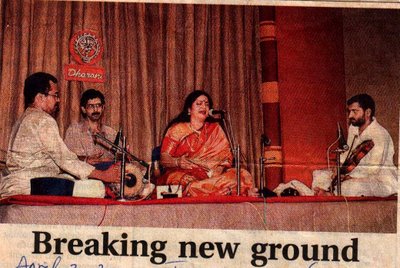
They have seen her dance, act and even sing some of those popular film hits on the stage, but to hear Srividya presenting a full Carnatic vocal was something the music buffs had not bargained for. It was quite natural then that the Kerala Fine Arts Hall filled in with a motley crowd that evening. There were many who had simply reached there to have a glimpse of their favourite star, others curious to find what she had in store for them and then the die-hard music fan hoping to hear an echo of her eminent mother, the late M..L.Vasanthakumari.
The concert organised by Society Dharani as its inaugural event in the series of classical music programmes with Srividya singing in a surprisingly high-pitch which she found difficult to sustain through the Thodi varanam, namely, Eraa naa pai. It must have left a few of the listeners keep their fingers crossed in trepidation. As the concert progressed she managed to get into her natural warble in her voice which gave altogether a pleasant feeling to a rather tensed audience.
Srividya resorted to a racy style of singing, quite rare among the present-day vocalists, choosing ragas and krithi to suit that particular mode of rendering. After Shobhillu, a Tyagarja krithi in Jaganmohini and a virutham , the delineation of Varali was made lively with the deft use of the ‘Gaandhaaram’. A late beginner, Srividya’s knowledge must have been acquired by listening to quality music during her childhood days and from her mother whom she used to accompany for concerts. The portrayal of Bilahari was compact. She seemed at ease with the Chinna Krishna Dasar’s Endha Brahma naadamu in roopakam but appeared to falter when she ventured into a bit of swara singing. Her ability to convey herself through compositions surfaced when she proceeded to sing Marugelaraa in Jayanthasree. She went into a detailed exploration of Kalyani which was resplendent in the use of light phrases. Rama ni vaadu by Tyagaraja was rendered in a manner to do credit to the late Sathur Subramaniam who popularised it. After Saaramaina in Behaug by Swathi, Srividya sang a couple of Meera bhajans which had traces of Misra Pahaadi and Misra Bhairavi respectively. Neena anaatha bandho by Purandaradasa in Nathanamakriya and a Sai bhajan, composed by herself., brought the conclusion of the concert. Nellore Nandan (violin),Vdavathur Sajeevan (mridangam) and Palghat Narayanan (ghatom) provided nice accompaniment.
By Courtesy – The Hindu- Kochi.
Bhavana Radhakrishnan at Thamarankulangara Sastha temple at Tripunithura.(
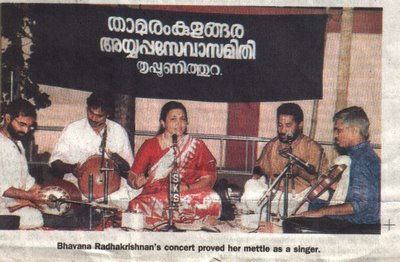
When film songs sung by professional Carnatic vocalists become a hit these maestros attract a big audience. Once when the late Jayasree, playback singer, sand at the Tripunithura temple there was a large gathering, a majority of which was looking forward to her hit song ‘Swapnangal Alangarikkum’ sung under the baton of Dakshinamoorthy for the movie, namely, Chumadu thaangi.
Bhavana Radhakrishnan shot into fame with the awrdwinning Kaithapram song in ‘Kaliyattom.’ There was a huge gathering at the Thamarankulangara Dharmasastha temple in Tripunithura when she performed in connection with the Makaravilakku festival. Being well trained vocalist under doyens like Mavelikkara Prabhakara Varma, she was able to prove her mettle by making the concert a sprightly one.
Her raga outlines were crystal-clear and the diction fascinating. She gave a solid footing to the concert with Gananathanai in Natta by T.Lakshmanan Pillai. Thenit was the turn for Pahimam Rajarajeswari in Janaranjini by Ramaswamy Sivan, a familiar one for Malayalam film music lovers.The delineation of Malayamarutham was dainty and Sastharam by Thulasivanam was in perfect harmony with the occasion and the surroundings. The sketch of Arabhi with Narasimhamamavam in Jhampa by Swathi displayed the conceptual clarity of the singer when yoked to a swara sequence. Vasantha was developed on delicate curves and Harihara Puthram by Deekshithar with its fabulous construction left a deep imprint. Edappally Ajith kept good company with the violin. Elenjimel Sushilkumar (mridamgam) and A. Anilkumar with the ghatom gave enthusiastic percussive support.
By Courtesy The Hindu-Kochi-21.3.05.
Divya B. Nair, Perumbavur
 The School State Youth Festivals held at the various levels culminating into State level have been throwing up talented students regularly. But those who win laurels for Carnatic music are seldom seen at a professional level, which is a bane for Kerala. But Divya B. Nair from Perumbavur who sang at the Hanuman temple auditorium in EKM, seemed to have learned the subtleties of Carnatic music. A disciple of Chandramana Narayanan Nambuthiri, she has a fascinating range and a pliable voice from which ‘Sangathis’ rolled out in a delectable fashion. Divya’s vocal held under the aegis of Tyagabrahmmam in connection with Gurupooja ( in commemoration of Aanjam Madhavan Nambuthiri and Dr S.Ramanathan ) began with ‘Saami dayajooda’ a varnam in Kedaragaula by Tirvottriyoor Thiyagaier. Vinayaka in Hamsadhwani by Veena Kuppayyar had a succinct swara phase. Nagumomu in Abheri paved the way for Anupama Gunambhudhi in Ataana and both were presented in a chaste fashion that was beyond her age. After Kuzhaloothi in Kambhoji by Oothukkadu , Thodi was there with its contours in order. Ninne namminaanu (chaappu) by Syama Sasthri had niraval and kalpanaswaras, tastefully presented. Thiruvizha Ullas played the violin suitably. Alappuzha Sreekanth, a disciple of Thiruvananthapuram Surendran handled the mridangam ably, with Mangalore Gopalkrishnan on the ghatom.
The School State Youth Festivals held at the various levels culminating into State level have been throwing up talented students regularly. But those who win laurels for Carnatic music are seldom seen at a professional level, which is a bane for Kerala. But Divya B. Nair from Perumbavur who sang at the Hanuman temple auditorium in EKM, seemed to have learned the subtleties of Carnatic music. A disciple of Chandramana Narayanan Nambuthiri, she has a fascinating range and a pliable voice from which ‘Sangathis’ rolled out in a delectable fashion. Divya’s vocal held under the aegis of Tyagabrahmmam in connection with Gurupooja ( in commemoration of Aanjam Madhavan Nambuthiri and Dr S.Ramanathan ) began with ‘Saami dayajooda’ a varnam in Kedaragaula by Tirvottriyoor Thiyagaier. Vinayaka in Hamsadhwani by Veena Kuppayyar had a succinct swara phase. Nagumomu in Abheri paved the way for Anupama Gunambhudhi in Ataana and both were presented in a chaste fashion that was beyond her age. After Kuzhaloothi in Kambhoji by Oothukkadu , Thodi was there with its contours in order. Ninne namminaanu (chaappu) by Syama Sasthri had niraval and kalpanaswaras, tastefully presented. Thiruvizha Ullas played the violin suitably. Alappuzha Sreekanth, a disciple of Thiruvananthapuram Surendran handled the mridangam ably, with Mangalore Gopalkrishnan on the ghatom.By Courtesy The Hindu (Kochi) March 29-02
Vijayalakshmi Subrahmaniam at the Chakkamkulangara temple
 Female vocalists attained a status on par with men because of the unstinted efforts by the late M.L.Vasanthakumari. Spurred on by her beloved mentor GNB, she happened to be the first woman vocalist to present ragam- thanam- pallavi which was till then considered a taboo for female singers. Vijayalakshmi Subrahmaniam (Chennai), who presented a vocal recital at the Chakkamkulangara temple at Tripunithura recently, displayed a deep insight in the Lakshya and Lakshana aspects. She had her initial training from K. Padmanabhan from Swathi Thirunal College of Music in Thiruvanathapuram and later was taught by K.Krishnaswamy.
Female vocalists attained a status on par with men because of the unstinted efforts by the late M.L.Vasanthakumari. Spurred on by her beloved mentor GNB, she happened to be the first woman vocalist to present ragam- thanam- pallavi which was till then considered a taboo for female singers. Vijayalakshmi Subrahmaniam (Chennai), who presented a vocal recital at the Chakkamkulangara temple at Tripunithura recently, displayed a deep insight in the Lakshya and Lakshana aspects. She had her initial training from K. Padmanabhan from Swathi Thirunal College of Music in Thiruvanathapuram and later was taught by K.Krishnaswamy. Her early days spent in Delhi were advantageous in imbibing the intricacies of Carnatic music from T.R. Subrahmaniam. V. K. Krishnan and S. Rajam have also given her advanced lessons. A post- graduate in Economics from Delhi (1983) and Punjab University, she has passed Sangeeth Siromani and Sangeeth Alankar exams from Delhi. A widely travelled Vijayalakshmi, has stayed in Newzealand to propagate Carnatic music. She has also conducted lec-dems and workshops abroad. Vijayalakshmi is adept in portraying ragas making their edifices clear at the very beginning and renders the compositions doing justice to their message and score.
The concert in Tripunithura began with a varnam in Vasantha, ‘Ninne kori’, by Thachur Singaracharlu, a desciple of Subbaraya Sasthri. Vandeham in Hamsadhwani was followed by Vidajaladura (Janaranjini ) in which Tyagaraja reveals himself as a constant devotee of the Lord. Santhanagopala by Deekshithar in Khamas and Sreevalli in Natabhairavi by P. Sivan served as a preamble to a detailed Panthuvarali which amply reflected the ‘Vidwath’ of the vocalist. Siva siva siva had an engaging niraval and swaras. Kailasanathane (Deekshithar) in Kambhoji and RTP in Simhendramadhyamam were the other major items. Attukal Balasubramanian gave a fine accompaniment with the violin. Chertala Jayadevan (mridangam) and Alappuzha Gopinatha Prabhu on the ghatom provided a steady percussion.
By Courtesy The Hindu (Kochi) March 29-02
Sunday, March 19, 2006
Mambalam sisters

When the virile Tiger Vradachari style is spiced up with that of the affable one by late Musiri Subrahmania Iyer a new palatable ‘bhaani’ is born. Mambalam sisters from Chennai who presented a vocal duet at Rasikapriya recently, were the desciples of B.V. aman and Lakshmanan before being trained by Suguna Varadachari. R. Vijayalakshmi and R. Chithra the daughters of the popular Ghanjira player K.S. Rangachari have thus acquired a firm musical conviction to make a Carnatic music programme a creative art than a mere act of self indulgence. Both of them possess an attractive voice and their tenacity in upholding the elementary virtues of sruthi and laya in perfect balance was revealed from the varnam in Sree ragam ( Saami ninne) by Karur Devudu Iyer. This was well appreciated by a large gathering at the Ernakulam Gramajana Samooham hall. Then they sang Vandeham in Hamsadhwani by Tallapakam Annamacharya, who was inspired by Vidyaranya, his predecessor. Musical notation for most of his krithis was done by Dr.Pinakapani and Nedunoori Krishnamoorthy. The sisters proceeded with Jaya Jaya Padmanabha in Manirangu by Maharaja Swathi Thirunal. Vijayalakshmi presented Begada along with Anudinamu by Poochi Iyengar. Nannu Vidachi (Reethigaula) in chappu by Tyagaraja, in absolute aurrender unto God with the message ‘My body is Yours’, was sung well. Saveri by Chithra was smooth. Sankari sankaru by Syama Sasthri in the dual frame work of rhythm, a speciality of his. Its inherent rhythm is in Roopakam while the suggestive one is in Aadi thaala in Thisra Gathi. The duo handled the niraval and swaras with professional ability. Somasundaram in Sudha Vasantha, an offspring of Dheera Sankarabharanam had a swaying effect. Dharamavathi. was shared between the sisters. In the ensuing ragam- thanam –pallavi musical ideas seemed to flourish and expand to the glee of the listeners. Maninoopura by Oothukadu Venkatasubbaier in Neelambari was followed by Naagasayanhari in Desh, a devotional composed by Natarajan, the father of the vocalist Raji Gopalakrishnan. Bhajore Bhayyaa by Kabirdas in Maandu, Kaatrinile varum geetham in Jonpuri which M.S. Subbalakshmi had rendered for the movie ‘Meera’, paved the way for Jnaanappana on Malyalam. Yaman Kalyan was projected through Jai jai devi by Swathi. Govardhana giridhari in Kanada by Narayana Theertha and Neenamame by Annamacharya containing the synonyms of Lord Vishnu were also there. R.Hemalatha, the youngest of the Mambalam Sisters gave a lovely accompaniment with the violin. The claasic touch in the Kumbhakonam style in mridangam initiated by Kumbhakonam Azhagunambia Pillai of yore reflected in the play of K. Ramakrishnan , disciple of Kumbhakonam Rajappa Iyer. K. S. Rangachari, trained by Harihara Sharma (father of Ghatom Vinayaka Ram) handled the ghanjira in a way that revealed his experience in the field.
January 25,2002. Courtesy The Hindu (Kochi).
Vocal by Srividya Venkatachalam

Whither Carnatic music? This is an oft-repeated question by the elderly fans of Carnatic music. They feel a qualitative dip when it comes to their preferences, in spite of the quantitative progress in terms of young vocalists and accompanists. These over-exposed youngsters cannot help feeling they have ‘arrived.’ But the elders stress on the fact that people like Ariyakudi, who had mastered several compositions in a single raga of Thodi or GNB who could breathe a new lease of life into any krithi, never looked complacent at any point of their career. But the recent vocal by Srividya Venkatachalam from Chennai, organised at Rasikapriya (30- 3 -2001) proved that the future of Carnatic music is not so bleak. She has a pleasing voice coupled with the knack to experience the transcendental emotion by herself first before sending it across the listeners in measured quantities. Beginning the concert with a varnam (Karunimpa idi) in Sahana by Tiruvottiyur Thyagaier, Srividya passed through Sidhivanayakam in Chamaram by Deekshithar and Narasimhamaamava by Swathi in Arabhi. The sturdiness of Ramanthapuram ‘bhaani’ imparted to her by Neyveli Santhangopalan ( a disciple of T.N. Seshagopalan whose guru was Ramanthapuram Sankarasivam) merged well the description of the ‘Ghana raga’, Varali. Mamava Meenakshi which Deekshithar had created on the deity of Madurai was rendered with grace. After Karunakara in Begada by Swathi, it was the turn of Hindolam. Srividya displayed her vocal quality by dwelling on the lower octaves without losing sight of of the ‘Jeeva’ of the raga when moving upward with the raga exposition. Niraval done on the charanam ‘Muraleevaadana Vinoda’ and the subsequent swara rendering showed that she is no more a fledgling vocalst. Yochana by Tyagaraja in Darbar could do without a sequence of Chittaswara and the vocalist would do well to realise that the composition has a natural development in the pallavi itself. The depiction of Mohanam was leisurely and methodical. Nanu Palimpa by Tyagaraja in Adi was an apt selection by the vocalist because of its correct balance between straight notes and the graced ones. Parvathy Vaidyanathan who played the violin has a great bowing technique. Kangazha Vasudevan (mridangam) and Kottayam Unnikrishnan (ghatom) supplied the right mode of percussion.
By Courtesy The Hindu 30.3.2001
Anuradha Krishnamurthi
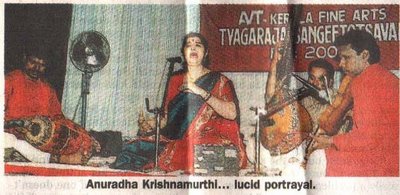
Anuradha Krishnamurthi, the daughter of Kollengode Viswanathan Narayanaswami (KVN) who sang on the second day of the music festival at Kerala Fine Arts Society Hall proceeded on the track suited to Sabha concerts with well selected ragas and compositions. The opening piece Panchamathangamukha (Roopakam) by Deekshithar in Malahari, was followed by Naada thanumanisham in Chitharanjini which has the frequencies of the notes of the Saamagana scale. Poorvikalyani was portrayed lucidly with Deva deva jagadeeswara by Swathi that has niraval ans swara. There was majesty in the depiction of Keeravani which was further supplemented by Kaligi yunte by Tygaraja. Neyveli Radahkrishna, a disciple of M.Chandrasekhran provided a pleasing acoompaniment on the violin. R.Yogaraja , a specialist in various South Indian percussions and a member of Dr.L. Subrahmaniam’s orchestral team played the mridangam with ease.
By Courtesy The Hindu March 1- 2001
Saturday, March 18, 2006
Nagamani Srinath at Rasikapriya,EKM
The late Chembai Vaidyanatha Bhagavathar during one of his visits to Tripunithura had remarked that Carnatic vocal music was rejuvenated by the genius of Madurai Pushpavanam. Around the same time Bidaram Krishnappa (guru of Chowdiah) gave an impetus to Carnatic music in the earstwhile state of Mysore. According to Chembai, Pushpavanam had a worthy successor in GNB, a post- graduate bhagavathar, with his vocal and physical attributes, though he arrived at the scene much later. But fate denied Krishnappa such a privilege. Yet, his relentless efforts blazing a new trail bore fruit with the appearance of young musicians from time to time. Mysore Nagamani Srinath who presented a vocal at Rasikapriya in Kochi , belongs to this category. A multidimensional personality, she has authored several books on music, apart from composing krithis in rare ragas as well as thillanas. The Head of the Department of Music in Mysore University, she is the desciple of Ramnad Krishnan, and her style has the imprint of M LV also, whom she considers as her Manasaguru. Nagamani began the concert with Bhrovabharama (Bahudhari) in which a fretful Tyagaraja asks the Lord how he could lift Govardhana easily while forgetting to save a devotee from the quagmire of worldly miseries. When she brought a flurry of swaras the composition was made more palatable. The mood in which the Saint of Tiruvarur had created Marugelara was reflected in her singing style. During the elaboration of Bilahari the refinement in voice that Nagamani has acquired by associating with vocalists like Syamala Bhave (Gwalior gharana) came to the fore. Paridaanamitchithe in Khandachappu by Pattanam Subrahmania Iyer was meticulously sung with a brief niraval and swara. Shanmughapriya assumed a vast dimension when Nagamani unearthed many of its hidden beauties through a pleasurable melodic excursion. Parvathi Nayakane with its effusive swara singing warmed up the concert. Govindaa by Purandaradasa in a rare raga known as Janasammodini from the Harikambhoji family was graceful. The Tamil ‘Bhaasuram’ (a flexible type of Tamil litereary work by Periya Alwar), tuned in Anandabhairavi, Kalyanvasantham, Sahana, and a thillana in Revathi composed by herself were the concluding pieces. Eswara Varma on the violin gave a satisfactory accompaniment. Krishnan with the mridangam and Vyasa Vittal on the ganjira ( both from Karnataka) were also good.
June8-2001 By Courtesy The Hindu.
Mamangalam Concert

Bharatheeya Sangeetha Sabha in Mamangalam, on the outskirts of Kochi, was recently established by veteran musician Madhusudhana Menon and a handful of music lovers to encourage young talents who lacked the opportunity to prove their mettle. A vocal recital by Perumbavur Sreeranjini under the aegis of the Sabha, held recently at the SNDP hall made an impact on the capacity crowd assembled there. Sreeranjini, a native of Tripunithura, and a product of RLV College of Music and Fine Arts there, has also been trained by Tripunithura K. Lalitha and later by Madhusudhana Menon. She is now settled in Perumbavoor. The vocalist has a pleasing voice and it surfaced with the Abhogi Varnam, Evvari bodhana itself, composed by Pattanam Subrahmania Iyer After Pramamamiaham (Gaula) by Mysore Vasudavachar, she rendered Govardhana Gireesham (Deekshithar) in Hindolam, set to Roopakam. Katahankuthoohalam is a raga designed by Pattanam Subrahmania Iyer, improving upon Kuthoohalam, a derivative of Dheera Sankarabharanam. The name itself implies that the raga and the krithi Raghuvamsa, are to be handled with a certain amount of finesse on part of the singer. Sreeranjini aquitted herself well by not providing undue acceleration to it. Anandabhairavi was delineated with thoughtfulness and Kamalamba in triputa by Deekshithar was presented with its full musical effect. This is the first among the Navavarana krithis. Kalyani was etched without making any excessive forays into the melodic region and Unnaal allal vere gathi by Papanasam Sivan was neatly laced with niraval and swaras. She packed the latter part of the concert with tempo by Karunai Daivame (Sindhubhairavi by Madhura Sreenivasan), Paarukkullen (Jonpuri) by Subrahmania Bharathi and the popular thillana in Dhanasari by Swathi. The vocalist concluded the concert with Niranna Peelikal, a verse in Malayalam which had dainty shades of Madhuvanthi. Thiruvizha Ullas provided an agreeable accompaniment on the violin. Gopakumar, a trained vocalist, handled the mridangam fairly well with Balachandran, a disciple of of the doyen Nandikeswara Rao, on the ghatom.
By Courtesy The Hindu Aug 17 2001
Sangeetha Shivakumar in EKM

Sangeetha Sivakumar, wife of T.M. Krishna, migrated to Chennai from Kochi as budding vocalist and became the disciple of Charumathy Ramachandran. Her concert in connection with the 26th Rama Navami Celebrations in Kochi showed that rigorous practice, efficient coaching and an environment conducive to the development of her innate flair for music, have made her performance worthy of note. Lack of clear diction when rendering the compositions of any language has been a malady inflicted on Carnatic music and Sangeetha took care not to fall prey to it. This was very evident in the way she sang Swaminatha at the very outset of the programme. Nannu vidachi was presented with a savouty version and in a reposeful tempo. Panthuvarali was breezy and Enna Gannu by Bhadrachalam Ramadas had an enlightened niraval. The swras tapering down to coverge with a ‘Mohara’ and expanding itself again had a touch of M LV in it. After Sarasasaama in Kaappinarayani, Kharaharpriya appeared in a garb of ‘bhrigas’ and that too used very sparingly. Effortless traversing of the upper regions added luster to her style in general. Chakkani Raja is reflective of the vedantha– bhaava and in the rendition of such a krithi the tempo should be chosen should also be appropriate, according to Tiger Varadachari..Sangeetha sang it beautifully, with a niraval of a high order. The swaras gave her the scope for a little bit of ‘vyavahara’ that merged well with the ‘padhathi’ adopted for it. Narayana came out with its melody and content hand in hand and Ramanaamathe composed by Rajani Viswanath in Vasantha turned out to be a surprise item. Pibare (Sadasivabrahmendra) in Ahirbhairav Radhasametha in Misrayaman and the Swathi thillana helped her to wrap up the concert. Thiruvizha Ullas played the violin with enthusiasm and veteran Parassala Ravi showed how an experienced mridangist should support a comparatively younger centrestage artiste. Nellai Santhosh (ghatom) and Sakthidharan with Mukharsanghu were the other side-men during the concert that took place on May3, 2002.
Aswini Deshpande

The sixth day of the Swathi Sangeetholsavam held at Kalikkotta palace of Tripunithura , under the auspices of Kerala Sangeetha Nataka Akademy was marked by the warble with which Aswini Bide Deshpande started her Hindusthani vocal with Bhoop (Mohanam) of Kalyan That, which wholly merged with the eventide. She pruned the Aalaap and the subsequent Khayal (theen thal) in order to favour the audience with a slant towards the Carantic classical. Swiftly traversing the phases of Asthai, Anthara, Sanchari and Abhog in the composition,.this microbiologist sang a couple of ‘taranas’ or thillana. The raga Megh from the Kafi That (Kharaharapriya), which is akin to Madhyamavathi of the South, found its expression through a composition, set to jhap tal and ek tal. It being the occasion of Holi, she sang a thumri (similar to padam) in Kapi. Aswini from Jaipur (trained by her mother Mani.K.Bhinde, Pundit Narayana Rao Datar and Pandit Ratnakar Pai in ‘Atrauli’ Khayal gayaki tradition) rendered a Kabir bhajan in the composite raga of Jogia Kanada. The large crowd was drenched in a wave of emotion when she rendered the Dakshinatya Basant (a seasonal raga), which the audience lapped up eagerly. The concluding piece was a mixture of Dadra-Khaherva rhythmic frame woven in Bhairavi or Sindhubhairavi.
By Courtesy The Hindu March 23-2001
Sudha Raghunathan at Ekm Shiva Temple.
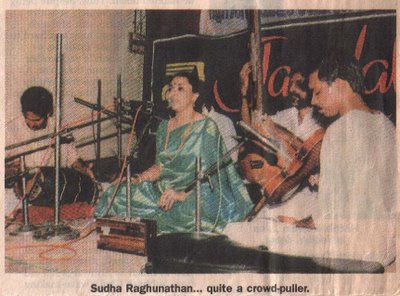
l
Courtesy THE HINDU (KOCHI) (Feb.16, 2001)
Whenever Sudha Raghunathan sings, the respective organisers can be assured of a packed house. Her concert that took place at the Ernakulam Siva temple during the festival had lilting raga delineations and lush swara settings. Although an unexpected downpour on the fifth day caused the concert to be shifted to the newly constructed auditorium from the templeyard, it did not diminish the enthusiasm of the huge crowd. A garland of swaras with which she beautified Varavallabha by GNB in Hamsadhwani earned a thunderous ovation. After Evarini by Tyagaraja in Devamrithavarshini, she rendered a virutham on Siva in Tamil and quickly sang Sreejalandhara in Gambhiranatta by the Maharaja of Mysore, that was supple in diction and with a melting melody. The delineation of Poorvikalyani was grand with the composition Anandanatamaadu by Neelakantasivan (roopakam) which has Jathi patterns adroitly attached to its Varnamettu. The most fascinating piece of the concert was the Deekshithar composition Sree Viswanatham woven into 14 rags with the raga mudra shown in them. Shankarabharanam was majestic and Sudha displayed her technical skill by pigmenting the raga with elements of Kalyani by virtue of Shruthibhedam. The concert attained its crescendo with Swara Raga Sudha Rasa by Tyagaraja. Edappally Ajth gava a tolerably good performance with the violin. Thrissur Jayaram played a few gripping ‘Theerumaanams’ on the mridangam. Adichanalloor Anilkumar kept good company with the ghatom.
Courtesy THE HINDU (KOCHI) (Feb.16, 2001)
Whenever Sudha Raghunathan sings, the respective organisers can be assured of a packed house. Her concert that took place at the Ernakulam Siva temple during the festival had lilting raga delineations and lush swara settings. Although an unexpected downpour on the fifth day caused the concert to be shifted to the newly constructed auditorium from the templeyard, it did not diminish the enthusiasm of the huge crowd. A garland of swaras with which she beautified Varavallabha by GNB in Hamsadhwani earned a thunderous ovation. After Evarini by Tyagaraja in Devamrithavarshini, she rendered a virutham on Siva in Tamil and quickly sang Sreejalandhara in Gambhiranatta by the Maharaja of Mysore, that was supple in diction and with a melting melody. The delineation of Poorvikalyani was grand with the composition Anandanatamaadu by Neelakantasivan (roopakam) which has Jathi patterns adroitly attached to its Varnamettu. The most fascinating piece of the concert was the Deekshithar composition Sree Viswanatham woven into 14 rags with the raga mudra shown in them. Shankarabharanam was majestic and Sudha displayed her technical skill by pigmenting the raga with elements of Kalyani by virtue of Shruthibhedam. The concert attained its crescendo with Swara Raga Sudha Rasa by Tyagaraja. Edappally Ajth gava a tolerably good performance with the violin. Thrissur Jayaram played a few gripping ‘Theerumaanams’ on the mridangam. Adichanalloor Anilkumar kept good company with the ghatom.
